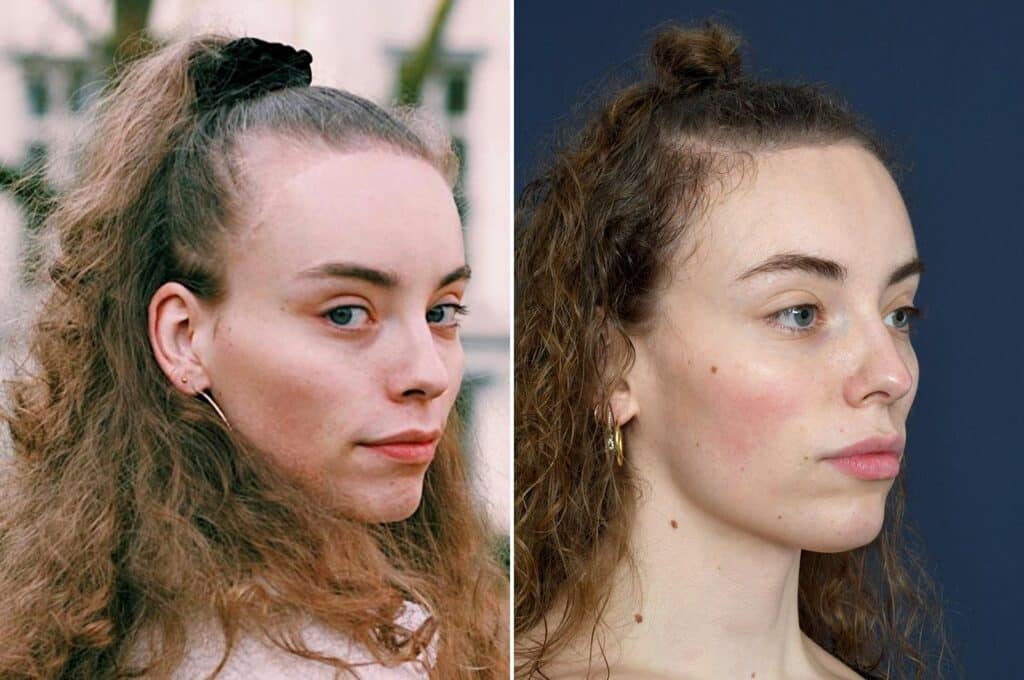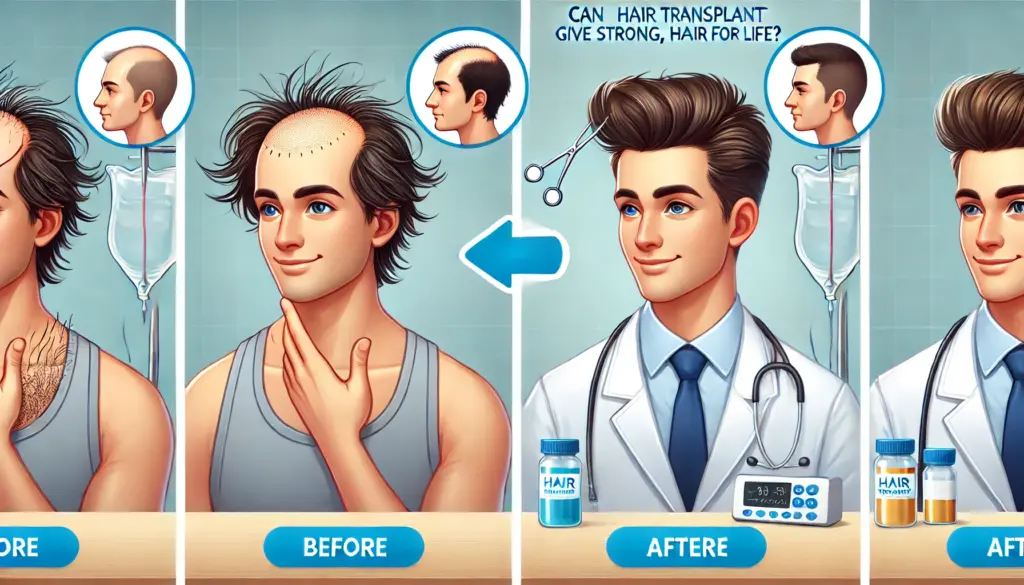Hair loss is a prevalent concern affecting millions of men and women worldwide. It can significantly impact self-esteem and confidence. While the reasons for hair loss vary, genetics, hormonal changes, aging, and medical conditions are all contributing factors. Fortunately, advancements in hair restoration have led to effective solutions, with hair transplant offering a long-term answer to hair loss woes.
Table of Contents
Understanding Hair Loss and the Role of Transplants
Hair naturally follows a growth cycle consisting of an active growth phase (anagen), a transitional phase (catagen), and a resting phase (telogen). During telogen, the hair follicle detaches from the scalp and eventually sheds. In cases of hair loss, this resting phase becomes prolonged, or the growth phase shortens, resulting in fewer hairs and a thinner scalp.
Hair transplants address this issue by relocating healthy hair follicles from a donor area on the scalp, typically the back and sides, which are genetically resistant to further hair loss, to areas experiencing thinning or baldness. This approach utilizes the body’s own resources to create new hair growth in the recipient areas.
It Offers Long-Term Benefits – A Stable Hairline for Years to Come
One of the most significant advantages of hair transplants is their long-term effectiveness. Unlike many other hair loss treatments that require ongoing use for maintenance, hair transplants offer a permanent solution. The transplanted follicles are genetically programmed not to be susceptible to the same hormonal influences that cause hair loss in other areas of the scalp. While the transplanted hair may thin slightly with age, just like natural hair, it won’t recede in the same pattern as your original hair loss. This means you can enjoy a more stable and predictable hairline for years to come.
The long-term results of a hair transplant offer a sense of security and confidence. Knowing that your hair loss has been addressed with a permanent solution can significantly improve your self-esteem and overall well-being.

You Must Understand The Factors Affecting Long-Term Results
Several factors influence the long-term success of a hair transplant. Choosing a qualified and experienced surgeon is paramount. A skilled surgeon will assess your scalp’s suitability for the procedure, recommend the most appropriate technique, and meticulously perform the transplant to minimize scarring and maximize graft survival.
Another important factor is following the surgeon’s post-operative instructions diligently. Proper care during the healing process ensures optimal graft survival and promotes healthy hair growth. Additionally, maintaining a healthy lifestyle with a balanced diet rich in essential vitamins and minerals can further contribute to the long-term health and vitality of your transplanted hair.
How Hair Transplants Offer A Long-Term Solution with Lasting Benefits
Hair loss is a common concern, affecting millions of men and women around the globe. It can significantly impact one’s self-esteem and confidence. While the causes of hair loss vary, genetics, hormonal changes, aging, and medical conditions all play a role. Fortunately, advancements in hair restoration have led to effective solutions like hair transplants, offering a long-term answer to hair loss.
While hair transplants provide a foundation for new hair growth in thinning areas, it’s important to remember that overall hair health is still influenced by your lifestyle habits. Just like any other part of your body, your hair thrives on a balanced diet rich in essential vitamins and minerals. Here’s how healthy habits can complement your hair transplant results:
- Balanced Diet: Nourish your hair from the inside out with a diet rich in vitamins, minerals, and protein. Biotin, iron, vitamin D, and omega-3 fatty acids are all crucial for healthy hair growth. Biotin helps convert nutrients into energy for hair cell production, while iron carries oxygen to the scalp, promoting hair follicle health. Vitamin D deficiencies have been linked to hair loss, and omega-3 fatty acids contribute to scalp health and circulation. Include a variety of fruits, vegetables, whole grains, lean proteins, and healthy fats in your diet for optimal hair health.
- Stress Management: Chronic stress can disrupt hair growth cycles and contribute to hair loss. Practice relaxation techniques like meditation, yoga, or deep breathing exercises to manage stress and promote overall well-being, which can positively impact your hair health.
- Scalp Care: Maintain a clean and healthy scalp environment by washing your hair regularly with a gentle shampoo and conditioner suitable for your hair type. Avoid harsh chemicals or excessive heat styling, which can damage the hair follicles. Gentle scalp massages can also improve circulation and promote hair growth.
- Adequate Sleep: Aim for 7-8 hours of quality sleep each night. During sleep, your body repairs and rebuilds itself, including hair follicles. Adequate sleep allows for optimal hair growth and reduces stress, further promoting a healthy scalp environment.
- Hydration: Dehydration can lead to dry, brittle hair that’s prone to breakage. Drink plenty of water throughout the day to stay hydrated and promote healthy hair growth.
Here Are The Essential Facts About Hair Transplants
Here’s a breakdown of some key facts about the hair transplant procedure:
The Process – Hair transplants involve meticulous relocation of healthy hair follicles from a donor area, typically the back and sides of the scalp, to areas experiencing thinning or baldness. These follicles are genetically resistant to further hair loss, offering a permanent solution. There are two main techniques used for hair transplants:
- Follicular Unit Transplantation (FUT): This technique involves removing a thin strip of scalp from the donor area, which is then dissected into individual follicular units for transplantation. While FUT leaves a linear scar, it allows for the extraction of a larger number of grafts in a single session.
- Follicular Unit Extraction (FUE): FUE involves extracting individual follicular units directly from the donor area using a specialized tool. This approach leaves behind minimal scarring, making it a good option for those who prefer a more cosmetically discreet outcome.
Cost – The cost of a hair transplant varies depending on several factors, including:
- Number of Grafts Needed: The number of grafts required will determine the overall cost of the procedure. More extensive hair loss will necessitate a greater number of grafts, leading to a higher cost.
- Surgeon’s Expertise: The experience and qualifications of the surgeon can significantly impact the cost. Renowned surgeons with extensive experience may charge a premium for their expertise.
- Geographic Location: The cost of a hair transplant can vary depending on the clinic’s location and operating costs.
It is essential to speak with a professional and experienced hair transplant surgeon prior to having hair transplanted. The surgeon will examine your scalp to see whether it is a good candidate for the operation, talk with you about your hair loss objectives, and suggest the best strategy for your particular situation during the consultation.

Choosing the Right Technique – FUT vs. FUE in Hair Transplants
Hair transplants have emerged as a highly sought-after solution for achieving long-term hair restoration. However, with different techniques available, choosing the right one for your needs can be a daunting task. This guide explores the two main techniques used in hair transplants – Follicular Unit Transplantation (FUT) and Follicular Unit Extraction (FUE) – highlighting their pros and cons to help you make an informed decision.
1 – Follicular Unit Transplantation (FUT):
This technique involves removing a thin strip of scalp, typically from the back and sides of the head, which is known as the donor area. This strip is then meticulously dissected under a microscope by a skilled technician into individual follicular units (groups of 1-4 hairs naturally occurring in the scalp). These extracted units are then implanted one by one into the recipient areas experiencing thinning or baldness.
| Pros of FUT: | Cons of FUT: |
| FUT is generally less expensive than FUE due to the faster extraction process and the ability to harvest a larger number of grafts in a single session.FUT allows for the extraction of a greater number of grafts in one session, making it suitable for individuals with extensive hair loss requiring a significant number of grafts.FUT has been a well-established technique for decades with a long history of successful outcomes. | FUT leaves a linear scar at the donor area where the scalp strip was removed. While the scar is often inconspicuous and can be concealed by hair, it may be a concern for some individuals.The FUT procedure requires stitches in the donor area, leading to a longer healing time compared to FUE.If the donor area is limited, FUT might not be the preferred option due to the need for a larger strip of scalp. |
2 – Follicular Unit Extraction (FUE):
FUE involves extracting individual follicular units directly from the donor area using a specialized tool. This minimally invasive technique creates tiny punch wounds at the extraction site, resulting in minimal scarring. The extracted follicular units are then meticulously implanted into the recipient areas for hair growth.
| Pros of FUE: | Cons of FUE: |
| FUE leaves minimal, scattered scars at the donor area, which are often barely noticeable and easily concealed by short hairstyles.FUE generally requires less recovery time than FUT due to the smaller extraction sites.FUE is a good choice for individuals who prefer a more cosmetically discreet outcome with minimal scarring.FUE is well-suited for individuals with a limited donor area as it allows for extracting individual grafts more strategically. | FUE is generally more expensive than FUT due to the time-consuming nature of extracting individual grafts.The FUE procedure may not be ideal for extensive hair loss as extracting a high number of grafts in a single session can be more time-consuming. Multiple sessions might be necessary.FUE requires a high level of skill and precision from the surgeon due to the intricate nature of extracting individual follicular units. |
Choosing Between Fut And Fue Can Feel Overwhelming
Both techniques offer long-term solutions for hair loss, but their approaches and outcomes differ. Here’s a breakdown to help you decide:
FUT (Follicular Unit Transplantation) – This procedure removes a thin strip of scalp from the donor area. This strip is then meticulously dissected into individual follicular units for transplantation. While FUT is generally less expensive due to faster extraction and a larger graft harvest, it leaves a linear scar in the donor area. Healing also takes longer due to stitches needed. However, FUT might be ideal for extensive hair loss as it allows for extracting a significant number of grafts in one session.
FUE (Follicular Unit Extraction) – This minimally-invasive technique directly extracts individual follicular units from the donor area using a specialized tool. This results in minimal, scattered scars that are easily concealed by short hairstyles. FUE offers a faster healing time and a cosmetically discreet outcome, making it ideal for those concerned about visible scarring. However, FUE comes at a higher cost due to the time-consuming nature of individual graft extraction. It may also require multiple sessions for extensive hair loss as fewer grafts can be extracted per session compared to FUT. Additionally, FUE relies heavily on the surgeon’s skill and experience due to the meticulous extraction process.
Ultimately, the best technique depends on your priorities. Consider your desired outcome: are you more concerned about cost-effectiveness and a single session, or minimizing scarring and achieving a cosmetically discreet look? Additionally, factor in the extent of your hair loss and your comfort level with potential scarring. A qualified hair transplant surgeon can assess your scalp and hair loss pattern to recommend the most suitable technique for achieving your desired results. By understanding the advantages and disadvantages of both FUT and FUE, you can make an informed decision and embark on your journey towards a fuller head of hair.
Conclusion: Hair Transplants Offer A Revolutionary Solution For Hire Loss
Hair transplants offer a revolutionary solution for individuals struggling with hair loss. By relocating healthy, genetically resistant hair follicles, they can significantly improve the density and appearance of thinning or balding areas. This permanent solution fosters a sense of security and confidence, allowing you to enjoy a fuller head of hair for years to come. However, maximizing the long-term health of your transplanted hair goes beyond the procedure itself. Maintaining a healthy lifestyle with proper diet, stress management, and scalp care practices plays a crucial role.
If you’re considering a hair transplant, consulting a qualified and experienced surgeon is the first step. They can assess your individual needs, discuss your goals, and recommend the most appropriate technique to achieve the desired outcome. With a thorough consultation and the right procedure, you can embark on a journey towards a renewed sense of confidence and a long-lasting solution for your hair loss concerns.

